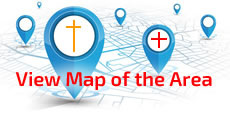The Sacred Heart And St. John Bosco Catholic Church
Arrangement in Honour of Pope Francis
There may be special arrangements in honour of Pope Francis, please check with the parish for more information.
You can sign our book of condolence here.
Churches
Chiswick Road, Hylton Castle Estate, Sunderland, SR5 3PY
People
Parish Priest
Contact
| Correspondence Address | The Presbytery St Joseph`s Presbytery Victoria Lane Coundon Co.durham DL14 8NL |
|---|---|
| Phone | 0191 548 0177 |
| Click here to email The Sacred Heart And St. John Bosco Catholic Church | |
Nearest Catholic Schools
St John Bosco RC Primary School School, Bradford Avenue, Town End Farm, Sunderland, SR5 4JW, UK
Nearest Catholic Parishes/Churches
The Holy Family Church, Gardiner Road, Grindon, Sunderland, SR4 0PS, UK
St. Anne Church, Hylton Road, Pennywell, Sunderland, SR4 9AA, UK
St. Hilda Church, Beaumont Street, Southwick, Sunderland, SR5 2JD, UK
The Sacred Heart Church, New Road, Boldon, Boldon Colliery, NE35 9DR, UK
St. Joseph Church, Paxton Terrace, Millfield, Sunderland, SR4 6HP, UK
Nearest Schools and Churches are calculated `as the crow flies` and may not be the closest or easiest when travelling.
About The Sacred Heart And St. John Bosco Catholic Church
Bishops' Conference: Bishops` Conference of England and Wales (Cymru)
Diocese: Diocese of Hexham and Newcastle
Parish of The Sacred Heart And St. John Bosco in Hylton Castle Estate, Sunderland (Diocese of Hexham & Newcastle).
Part of the Catholic Church - you can find other Catholic Churches, Catholic Schools or Religious Orders/Houses and Chaplaincies nearby above. Or you can use the Find a Church Near Me box above to search for a Church, School etc.
Useful Definitions of the Structures in the Catholic Church
What is a Catholic Bishops' Conference?
An episcopal conference, sometimes called a conference of bishops, is an official assembly of the bishops of the Catholic Church in a given territory. ... Individual bishops do not relinquish their immediate authority for the governance of their respective dioceses to the conference (Wikipedia).
What is an Archdiocese?
Dioceses ruled by an archbishop are commonly referred to as archdioceses; most are metropolitan sees, being placed at the head of an ecclesiastical province. A few are suffragans of a metropolitan see or are directly subject to the Holy See.
The term 'archdiocese' is not found in Canon Law, with the terms "diocese" and "episcopal see" being applicable to the area under the ecclesiastical jurisdiction of any bishop.[8] If the title of archbishop is granted on personal grounds to a diocesan bishop, his diocese does not thereby become an archdiocese (Wikipedia).
What is a Diocese?
The group of churches that a bishop supervises is known as a diocese. Typically, a diocese is divided into parishes that are each overseen by a priest.
The original dioceses, in ancient Rome, were political rather than religious. Rome was divided into dioceses, each of which was made up of many provinces. After Christianity became the Roman Empire's official religion in the 4th century, the term gradually came to refer to religious districts. The Catholic Church has almost 3,000 dioceses. The Greek root of diocese is dioikesis, "government, administration, or province." (Vocabulary.com).
As of April 2020, in the Catholic Church there are 2,898 regular dioceses: 1 papal see, 649 archdioceses (including 9 patriarchates, 4 major archdioceses, 560 metropolitan archdioceses, 76 single archdioceses) (Wikipedia).
What is the difference between a Diocese and an Archdiocese?
Each diocese is within a Province - a group of Dioceses - the Archdiocese is the main Diocese within that Diocese. The bishop of that Archdiocese is therefore automatically an Archbishop. If a bishop has been made an Archbishop personally is referred to as an Archbishop but it does not make their Diocese an Archdiocese.
What is a Deanery?
A subdivision of a diocese, consisting of a number parishes, over which presides a dean appointed by a bishop. The duty of the dean is to watch over the clergy of the deanery, to see that they fulfill the orders of the bishop, and observe the liturgical and canon laws. He summons the conference of the deanery and presides at it. Periodically he makes a report to the bishop on conditions in the deanery.www.catholicculture.org
What is a Parish?
In the Roman Catholic Church, a parish (Latin: parochia) is a stable community of the faithful within a particular church, whose pastoral care has been entrusted to a parish priest (Latin: parochus), under the authority of the diocesan bishop. It is the lowest ecclesiastical subdivision in the Catholic episcopal polity, and the primary constituent unit of a diocese. In the 1983 Code of Canon Law, parishes are constituted under cc. 515–552, entitled "Parishes, Pastors, and Parochial Vicars." Wikipedia





.png)
